
The second USS Boston was a 24-gun frigate, launched 3 June 1776 by Stephen and Ralph Cross, Newburyport, Massachusetts, and completed the following year. In American service she captured a number of British vessels. The British captured Boston at the fall of Charleston, South Carolina, renamed her HMS Charlestown, and took her into service. She was engaged in one major fight with two French frigates, which she survived and which saved the convoy she was protecting. The British sold Charlestown in 1783, immediately after the end of the war.

The action of 25 September 1806 was a naval battle fought during the Napoleonic Wars off the French Biscay port of Rochefort. A French squadron comprising five frigates and two corvettes, sailing to the French West Indies with supplies and reinforcements, was intercepted by a British squadron of six ships of the line that was keeping a close blockade of the port as part of the Atlantic campaign of 1806. The British ships, under the command of Commodore Sir Samuel Hood, spotted the French convoy early in the morning of 25 September, just a few hours after the French had left port, and immediately gave chase. Although the French ships tried to escape, they were heavily laden with troops and stores, and the strong winds favoured the larger ships of the line, which caught the French convoy after a five-hour pursuit, although they had become separated from one another during the chase.

Charles-Alexandre Léon Durand, comte de Linois was a French Navy officer, nobleman and colonial administrator who served in the American Revolutionary War and the French Revolutionary and Napoleonic Wars. He commanded the combined Franco-Spanish fleet during the Algeciras campaign in 1801, winning the First Battle of Algeciras before losing the Second Battle of Algeciras.
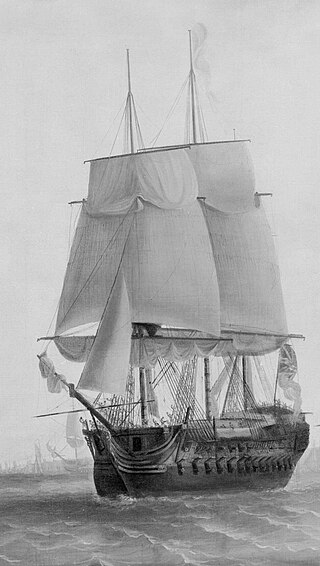
Courageux was a 74-gun ship of the line of the French Navy, launched in 1753. She was captured by the Royal Navy in 1761 and taken into service as HMS Courageux. In 1778 she joined the Channel Fleet, and she was later part of the squadron commanded by Commodore Charles Fielding that controversially captured a Dutch convoy on 31 December 1779, in what became known as the Affair of Fielding and Bylandt. On 4 January 1781, Courageux recaptured Minerva in a close-range action west of Ushant that lasted more than an hour. That April, Courageux joined the convoy under George Darby which successfully relieved the Great Siege of Gibraltar.

HMS Latona was a 36-gun, fifth-rate frigate of the Royal Navy that served during the American Revolutionary War, the French Revolutionary Wars, and the Napoleonic Wars. Shortly after her launch in 1781, she participated in the Battle of Dogger Bank against a Dutch squadron in the North Sea. In September 1782, Latona took part in the relief of Gibraltar and was the first ship in the convoy to pass through the Straits, when Richard Howe sent her ahead, to spy on the condition of the Franco-Spanish fleet in Algeciras Bay.
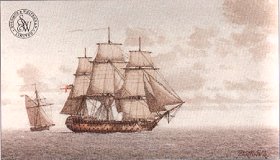
HMS Edgar was a 74-gun third-rate ship of the line of the Royal Navy, that saw service in the American Revolutionary, French Revolutionary and Napoleonic Wars. Launched in 1779, she fought in the battles of Cape St Vincent and Copenhagen, two of the major naval engagements of the wars.

Fénix was an 80-gun ship of the line (navio) of the Spanish Navy, built by Pedro de Torres at Havana in accordance with the system laid down by Antonio Gaztaneta launched in 1749. In 1759, she was sent to bring the new king, Carlos III, from Naples to Barcelona. When Spain entered the American Revolutionary War in June 1779, Fénix set sail for the English Channel where she was to join a Franco-Spanish fleet of more than 60 ships of the line under Lieutenant General Luis de Córdova y Córdova. The Armada of 1779 was an invasion force of 40,000 troops with orders to capture the British naval base at Portsmouth.
HMS Boyne was a 70-gun third rate ship of the line of the Royal Navy, built at Plymouth Dockyard to the draught specified in the 1745 Establishment as amended in 1754, and launched on 31 May 1766. She was first commissioned for the Falkland Crisis of 1770 after which, in 1774, she sailed for North America. From March 1776, she served in the English Channel then, in May 1778, she was sent to the West Indies where she took part in the battles of St Lucia, Grenada and Martinique. In November 1780, Boyne returned home, where she was fitted for ordinary at Plymouth. In May 1783, she was broken up.
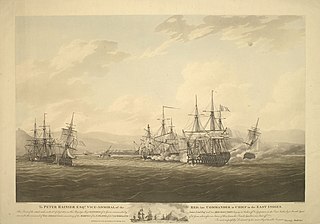
HMS Centurion was a 50-gun Salisbury-class fourth rate of the Royal Navy. She served during the American War of Independence, and during the French Revolutionary and Napoleonic Wars.

The action of 7 April 1800 was a minor naval engagement fought between a British squadron blockading the Spanish naval base of Cádiz and a convoy of 13 Spanish merchant vessels escorted by three frigates, bound for the Spanish colonies in the Americas. The blockade squadron consisted of the ships of the line HMS Leviathan and HMS Swiftsure and the frigate HMS Emerald, commanded by Rear-Admiral John Thomas Duckworth on Leviathan. The Spanish convoy sailed from Cádiz on 3 April 1800 and encountered Duckworth's squadron two days later. The Spanish attempted to escape; Emerald succeeded in capturing one ship early on 6 April. The British captured a brig the following morning and the British squadron divided in pursuit of the remainder.

The action of 26 April 1797 was a minor naval engagement during the French Revolutionary Wars in which a Spanish convoy of two frigates was trapped and defeated off the Spanish town of Conil de la Frontera by British ships of the Cadiz blockade. The British vessels, the ship of the line HMS Irresistible and the Fifth-rate frigate HMS Emerald, were significantly more powerful than the Spanish frigates, which were on the last stage of a voyage carrying treasure from Havana, Cuba, to the Spanish fleet base of Cadiz.

The action of 30 September 1780 was a minor naval engagement off the Bermudas, where HMS Pearl captured Espérance, a French frigate of 32 guns launched in 1779.

The Battle of Mykonos was a minor naval engagement fought in the main harbour of the Cycladic island of Mykonos on 17 June 1794 during the French Revolutionary Wars. A British Royal Navy squadron led by fourth rate ship HMS Romney was escorting a convoy of eight merchant ships westwards through the Aegean Sea to Smyrna when the French frigate Sibylle was sighted at anchor in the harbour of Mykonos town with three French merchant ships. Ordering the convoy to continue with the rest of the squadron, Captain William Paget diverted the 50-gun Romney to the port and demanded the surrender of the 40-gun French ship and its convoy.
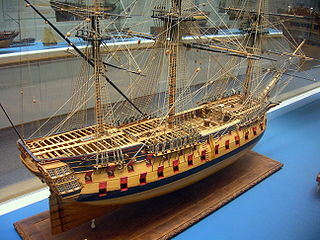
The action of 17 July 1761 was a naval engagement fought off the Spanish port of Cádiz between a British Royal Navy squadron and a smaller French Navy squadron during the Seven Years' War. British fleets had achieved dominance in European waters over the French following heavy defeats of French fleets in 1759. To maintain this control, British battle squadrons were stationed off French ports, as well as ports in neutral but French-supporting Spain which sheltered French warships. In 1761, two French ships, the 64-gun ship of the line Achille and 32-gun frigate Bouffone were blockaded in the principal Spanish naval base of Cádiz, on the Southern Atlantic coast of Spain.
The Battle of Guadeloupe or the Action of 21–22 December 1779 was a naval engagement that took place off the French island of Guadeloupe in the Caribbean during the American Revolutionary War between three Royal Navy ships and three French Navy frigates. The Royal Navy under Joshua Rowley sighted and promptly chased the French frigates, all of which were captured after a brief fight.
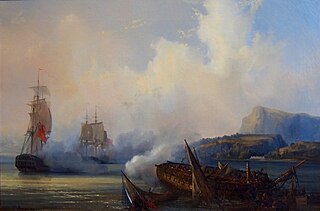
The Battle of Port Louis was a minor naval engagement of the French Revolutionary Wars, fought on 11 December 1799 at the mouth of the Tombeau River near Port Louis on the French Indian Ocean island of Île de France, later known as Mauritius. Preneuse had originally been part of a powerful squadron of six frigates sent to the Indian Ocean in 1796 under the command of Contre-amiral Pierre César Charles de Sercey, but the squadron dispersed in 1798 and by the summer of 1799 Preneuse was the only significant French warship remaining in the region. The battle was the culmination of a three-month raiding cruise by the 40-gun French Navy frigate Preneuse, commanded by Captain Jean-Matthieu-Adrien Lhermitte. Ordered to raid British commerce in the Mozambique Channel, Lhermitte's cruise had been eventful, with an inconclusive encounter with a squadron of small British warships in Algoa Bay on 20 September and an engagement with the 50-gun HMS Jupiter during heavy weather on 9–11 October.
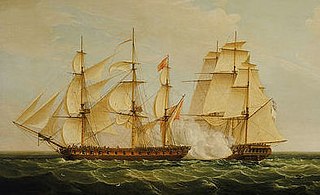
HMS Pearl was a fifth-rate, 32-gun British Royal Navy frigate of the Niger-class. Launched at Chatham Dockyard in 1762, she served in British North America until January 1773, when she sailed to England for repairs. Returning to North America in March 1776, to fight in the American Revolutionary War, Pearl escorted the transports which landed troops in Kip's Bay that September. Much of the following year was spent on the Delaware River where she took part in the Battle of Red Bank in October. Towards the end of 1777, Pearl joined Vice-Admiral Richard Howe's fleet in Narragansett Bay and was still there when the French fleet arrived and began an attack on British positions. Both fleets were forced to retire due to bad weather and the action was inconclusive. Pearl was then despatched to keep an eye on the French fleet, which had been driven into Boston.
The Battle of the Windward Passage was a small naval action between French and British fleets that occurred on 17 to 19 October 1760 during the Seven Years' War. The action took place in the Caribbean between Cap-Français and Eastern Cuba and resulted in a British victory.

The action of 29 July 1782 was a minor naval engagement that took place towards the end of the American War of Independence. The British Royal Navy frigate HMS Santa Margarita captured the 36-gun French frigate Amazone off Cape Henry, but the next day the squadron under Louis-Philippe de Vaudreuil intervened and recaptured the frigate.

HMS Santa Monica was a Spanish frigate which battled the British HMS Pearl in 1778, off the Azores. It was built in 1777 in Cartagena, Spain and launched as Santa Ammonica. It was taken as a prize in the 1778 battle, commissioned into the Royal Navy and renamed in 1779, but a few years later was grounded off Tortola in the British Virgin Islands, and was broken up. Its wreck was later found in what is now the territory of the U.S. Virgin Islands.
















